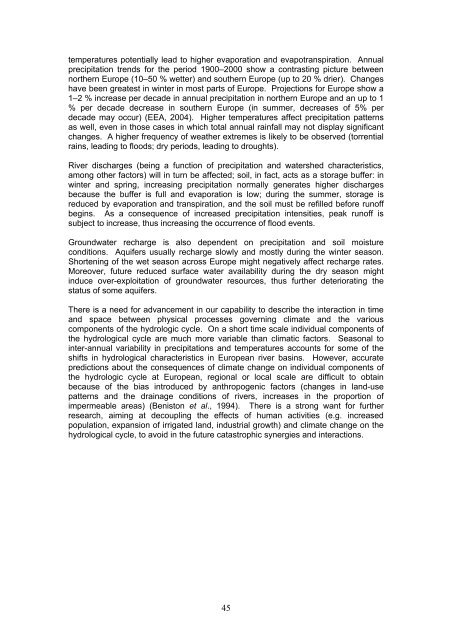Climate Change and the European Water Dimension - Agri ...
Climate Change and the European Water Dimension - Agri ...
Climate Change and the European Water Dimension - Agri ...
You also want an ePaper? Increase the reach of your titles
YUMPU automatically turns print PDFs into web optimized ePapers that Google loves.
temperatures potentially lead to higher evaporation <strong>and</strong> evapotranspiration. Annual<br />
precipitation trends for <strong>the</strong> period 1900–2000 show a contrasting picture between<br />
nor<strong>the</strong>rn Europe (10–50 % wetter) <strong>and</strong> sou<strong>the</strong>rn Europe (up to 20 % drier). <strong>Change</strong>s<br />
have been greatest in winter in most parts of Europe. Projections for Europe show a<br />
1–2 % increase per decade in annual precipitation in nor<strong>the</strong>rn Europe <strong>and</strong> an up to 1<br />
% per decade decrease in sou<strong>the</strong>rn Europe (in summer, decreases of 5% per<br />
decade may occur) (EEA, 2004). Higher temperatures affect precipitation patterns<br />
as well, even in those cases in which total annual rainfall may not display significant<br />
changes. A higher frequency of wea<strong>the</strong>r extremes is likely to be observed (torrential<br />
rains, leading to floods; dry periods, leading to droughts).<br />
River discharges (being a function of precipitation <strong>and</strong> watershed characteristics,<br />
among o<strong>the</strong>r factors) will in turn be affected; soil, in fact, acts as a storage buffer: in<br />
winter <strong>and</strong> spring, increasing precipitation normally generates higher discharges<br />
because <strong>the</strong> buffer is full <strong>and</strong> evaporation is low; during <strong>the</strong> summer, storage is<br />
reduced by evaporation <strong>and</strong> transpiration, <strong>and</strong> <strong>the</strong> soil must be refilled before runoff<br />
begins. As a consequence of increased precipitation intensities, peak runoff is<br />
subject to increase, thus increasing <strong>the</strong> occurrence of flood events.<br />
Groundwater recharge is also dependent on precipitation <strong>and</strong> soil moisture<br />
conditions. Aquifers usually recharge slowly <strong>and</strong> mostly during <strong>the</strong> winter season.<br />
Shortening of <strong>the</strong> wet season across Europe might negatively affect recharge rates.<br />
Moreover, future reduced surface water availability during <strong>the</strong> dry season might<br />
induce over-exploitation of groundwater resources, thus fur<strong>the</strong>r deteriorating <strong>the</strong><br />
status of some aquifers.<br />
There is a need for advancement in our capability to describe <strong>the</strong> interaction in time<br />
<strong>and</strong> space between physical processes governing climate <strong>and</strong> <strong>the</strong> various<br />
components of <strong>the</strong> hydrologic cycle. On a short time scale individual components of<br />
<strong>the</strong> hydrological cycle are much more variable than climatic factors. Seasonal to<br />
inter-annual variability in precipitations <strong>and</strong> temperatures accounts for some of <strong>the</strong><br />
shifts in hydrological characteristics in <strong>European</strong> river basins. However, accurate<br />
predictions about <strong>the</strong> consequences of climate change on individual components of<br />
<strong>the</strong> hydrologic cycle at <strong>European</strong>, regional or local scale are difficult to obtain<br />
because of <strong>the</strong> bias introduced by anthropogenic factors (changes in l<strong>and</strong>-use<br />
patterns <strong>and</strong> <strong>the</strong> drainage conditions of rivers, increases in <strong>the</strong> proportion of<br />
impermeable areas) (Beniston et al., 1994). There is a strong want for fur<strong>the</strong>r<br />
research, aiming at decoupling <strong>the</strong> effects of human activities (e.g. increased<br />
population, expansion of irrigated l<strong>and</strong>, industrial growth) <strong>and</strong> climate change on <strong>the</strong><br />
hydrological cycle, to avoid in <strong>the</strong> future catastrophic synergies <strong>and</strong> interactions.<br />
45













